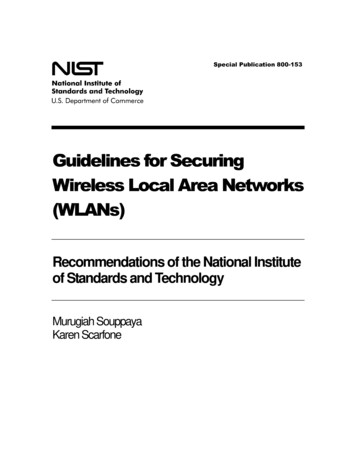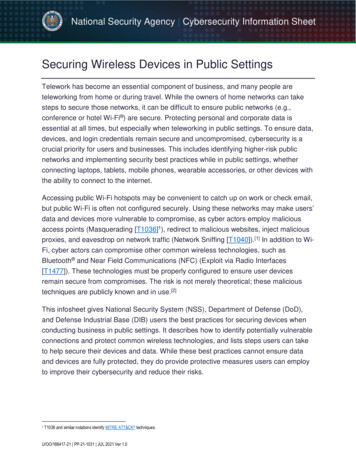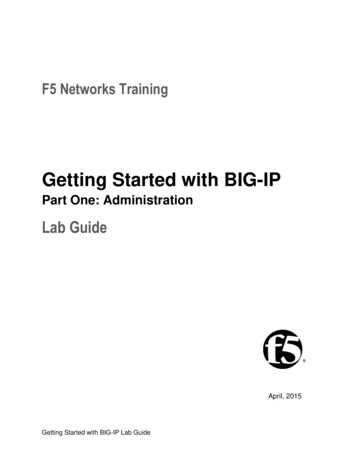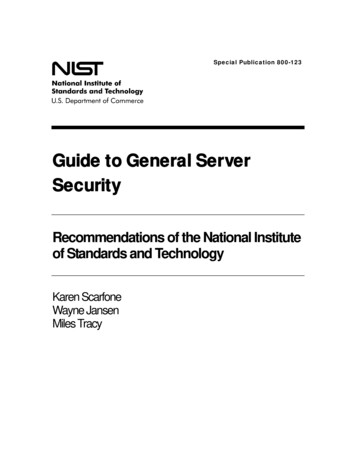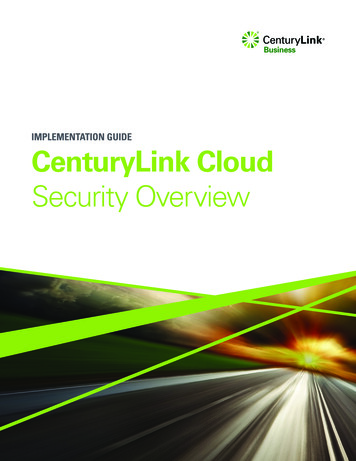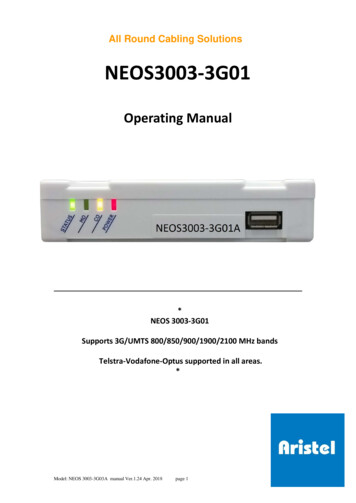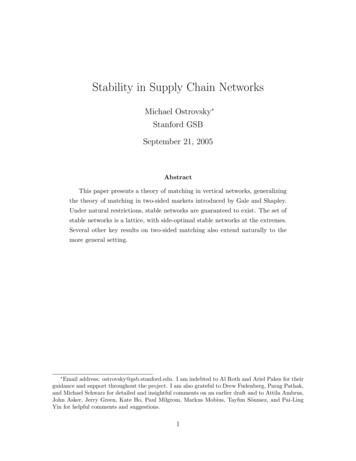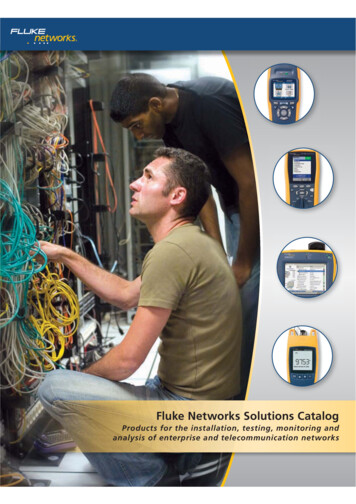
Transcription
A Guide to Securing Networks for Wi-Fi(IEEE 802.11 Family)A Guide to Securing Networksfor Wi-Fi (IEEE 802.11 Family)Department of Homeland SecurityCybersecurity EngineeringVersion 1.0 – March 15, 2017i
A Guide to Securing Networks for Wi-Fi(IEEE 802.11 Family)Prepared ByUnited States Department of Homeland Security (DHS)Cybersecurity EngineeringRevision HistoryVersion1.0Date3/15/17DescriptionFirst ReleaseAuthorsDHSiSection/PageAll
A Guide to Securing Networks for Wi-Fi(IEEE 802.11 Family)1.Table of ContentsIntroduction . 12.Threat Types . 23.Threat Remediation . 34.Recommended Requirements for Enterprise Wireless Networking . 35.Recommended Requirements for WIDS/WIPS . 46.Recommended Requirements for Wireless Surveys . 57.Budget Estimation Guide. 78.Bluetooth Security Considerations . 8Appendix A: Authorities and References . 10Appendix B: Acronyms and Abbreviations . 12ii
A Guide to Securing Networks for Wi-Fi(IEEE 802.11 Family)1. IntroductionThis guide summarizes leading practices and technical guidance for securing networks fromwireless threats and for securely implementing wireless access to networks. This document isspecifically focused on the wireless technologies commonly referred to as “Wi-Fi” as defined inthe Institute of Electrical and Electronics Engineers (IEEE) 802.11 family. This guide does notinclude commercial mobile networks (e.g., 3GPP, LTE). The recommendations in this guideaddress wireless threats that are universal to all networks and describe security controls that canwork together to mitigate these threats.Wireless capabilities are widely available, even on networks that are not intentionally providingthese services. Wi-Fi signals may infiltrate buildings from commercial providers, adjacentbuildings and businesses, and other publicly available services. Authorized and unauthorized WiFi services can be used to gain unauthorized access to networks that are otherwise stronglysecured. Due to the pervasive nature of Wi-Fi, it is important to consider the risks associatedwith these technologies and to examine potential impacts to confidentiality, availability, andintegrity when conducting risk and threat analyses. On March 31, 2014, the FederalCommunications Commission (FCC) increased the availability of the radio frequency (RF)spectrum for high-speed, high-capacity Wi-Fi in the 5 GHz band in support of the everincreasing demand for Wi-Fi data connectivity. 1In response to the growing number of attacks on networks and the risks associated with thepervasive nature of wireless technologies, a number of wireless security guides have beenproduced by commercial interests, the Federal Government, and the Department of Defense(DoD). Two of the SANS CIS 2 Critical Security Controls for Effective Cyber Defense v6.0—Boundary Defense (Critical Security Control (CSC) 12) and Wireless Access Control (CSC15)—are specific to wireless risks and threats.A major recommendation in the guidance above is to deploy a wireless intrusion detectionsystem (WIDS) and wireless intrusion prevention system (WIPS) on every network, even whenwireless access to that network is not offered, to detect and automatically disconnect devicesusing unauthorized wireless services.CSC 12 and CSC 15 recommend monitoring for communication between networks of differenttrust levels and specifically calling out WIDS as part of the technical approach for monitoringcommunication. DoD Directive 8100.2, Use of Commercial Wireless Devices, Services, andTechnologies in the Department of Defense (DoD) Global Information Grid (GIG), includes theDoD policy for addressing Wi-Fi threats to both wireless local area networks (WLANs) as well1Link to FCC announcement: ectrum-wi-fi-other-unlicenseduses2According to the SANS Institute, the “SANS CIS Critical Security Controls are a recommended set of actions forcyber defense that provide specific and actionable ways to stop today's most pervasive and dangerous attacks.” SeeAppendix A for link to the SANS CIS webpage.1
A Guide to Securing Networks for Wi-Fi(IEEE 802.11 Family)as wired networks. The directive requires that an active screening capability for wireless devicesbe implemented on every DoD network. In July 2016, the Office of the Director of NationalIntelligence issued guidance requiring WIDS capabilities for continuous monitoring.The significant increase of wireless technology in and around enterprise networks hascorrespondingly increased the associated risks. These risks include neighboring Wi-Fi networks,hot spots, hotels, mobile hotspot devices such as mobile Wi-Fi (MiFi), and a multitude of mobiledevices and smart phones that have Wi-Fi capabilities. The focus on securing enterprise wirednetworks (through technologies such as firewalls, intrusion prevention systems (IPSs), contentfilters, and anti-virus and anti-malware detection tools) has made enterprise networks a moredifficult target for adversaries. As a result, adversaries are now exploiting less secure end userdevices and Wi-Fi networks to penetrate enterprise networks.In June 2009, Gartner, Inc., a technology research company, performed a study entitled “NextGeneration Threats and Vulnerabilities.” This study concluded that Wi-Fi infrastructureattacks had the highest level of severity and the lowest time to invest for the attacker. Whileimprovements have been made in Wi-Fi technologies since the time of this report that improvethe basic security of Wi-Fi systems, users are still a weak link and must have a significantunderstanding of the technology in order to safeguard against many types of attacks. Theautomation of connections for ease of use and insecure default configurations can lead users toinadvertently compromise the security of their device or network.2. Threat TypesBy not addressing wireless security, enterprise networks are exposed to the threats listed below.Monitoring for wireless activity and devices enables an enterprise to have better visibility intoWi-Fi use and to identify and mitigate Wi-Fi-related threats. Wi-Fi threats include: Hidden or Rogue Access Points (APs) – unauthorized wireless APs attached to theenterprise network may not transmit their service set identifier (SSID) to hide theirexistence.Misconfigured APs – APs with weak or incorrect settings that allow unauthorizeddevices to connect or expose connection communications to sniffing and replay attacks.Banned Devices – devices not allowed on the network by organizational policy (e.g.,wireless storage devices).Client Mis-association (e.g., department and agency (D/A)) clients connecting to nonD/A networks while at D/A sites) – clients using unsecured and unmonitored networkswhen secured and monitored network connections are available increases the risk of dataloss and system compromise.Rogue Clients – unauthorized clients attaching to the network. Rogue clients pose risksof bridging and data loss as well as circumventing established security controls andmonitoring efforts.Internet Connection Sharing and Bridging Clients – a device that shares its Internetconnection or allows connectivity to multiple networks concurrently can be used to2
A Guide to Securing Networks for Wi-Fi(IEEE 802.11 Family) bypass network monitoring and security controls and may result in data loss or providean unsecured network entry point for an attacker.Unauthorized Association – an AP-to-AP association that can violate the securityperimeter of the network.Ad hoc Connections – a peer-to-peer network connection that can violate the securityperimeter of the network.Honeypot/Evil Twin APs – an AP setup to impersonate authorized APs interceptingnetwork communications and compromising systems that connect to it.Denial of Service (DoS) Attacks – an attack that seeks to overwhelm the system causingit to fail or degrade its usability. These attacks are frequently used in conjunction withother attacks (e.g., honeypot) to encourage a wireless client to associate withcompromised wireless APs.3. Threat RemediationAn active WIDS/WIPS enables enterprise networks to create and enforce wireless securitypolicies. WIDS/WIPS provides the ability to centrally monitor and manage enterprise wirelesssecurity with respect to the various threats listed above. Alternatively, during an incident relatedto these threats, an on-site technician would be required to survey the entire enterprise with alaptop or other wireless network detection device in an attempt to locate and identify a rogue AP.Having a WIDS/WIPS capability in place greatly aids in incident remediation.Successfully identifying and mitigating rogue APs and wireless devices is a challenging andlabor-intensive process, as rogue APs are frequently moved and not always powered on. AWIDS/WIPS capability provides immediate automated alerts to the enterprise security operationscenter (SOC) and can be configured to automatically prevent any clients from attaching to rogueAPs. WIDS/WIPS capabilities are also useful for physically locating rogue APs in order toremove them.4. Recommended Requirements for Enterprise Wireless NetworkingListed below are sample requirements for consideration when securing an enterprise networkfrom wireless threats. These requirements are derived from the sources listed in Appendix A:Authorities and References and should be tailored to specific considerations and applicablecompliance requirements. These requirements are currently tailored to guidance applicable tofederal Executive Branch D/As. Use existing equipment that can be securely configured and is free from knownvulnerabilities where possible.Meet Federal Information Processing Standards (FIPS) 140-2 compliance for encryption.Be compliant to relevant National Institute of Standards and Technology (NIST) 800-53controls.3
A Guide to Securing Networks for Wi-Fi(IEEE 802.11 Family) Use the certificates that reside on personal identification verification (PIV) cards for userauthentication to comply with Office of Management and Budget (OMB) HomelandSecurity Presidential Directive 12 (HSPD-12).Support an alternative method of certificate authentication where PIV cannot be used.Use Extensible Authentication Protocol-Transport Layer Security (EAP-TLS 3) certificatebased methods or better for to secure the entire authentication transaction andcommunications.Minimally use Advanced Encryption Standard (AES) counter mode cipher blockchaining message authentication code 4 protocol (CCMP), a form of AES encryptionutilized by Wireless Application Protocol (WAP) 2 enterprise networks. More complexencryption technologies supporting the requirement for an enhanced data cryptographicencapsulation mechanism providing confidentiality and the client’s capabilities whileconforming to FIPS 140-2 may be used as they are developed and approved.Allow for enterprise users to operate seamlessly and allow for login scripts and loginactivities to function normally. Wireless access clients should be able to transition fromAP-to-AP with no service disruption while maintaining the security of the connection.5. Recommended Requirements for WIDS/WIPSEven wired networks that do not support wireless access should utilize a WIDS/WIPS solution tomonitor and detect rogue APs and unauthorized connections. The following list includes specificrecommended requirements for WIDS/WIPS sensor networks and should be tailored based onlocal considerations and applicable compliance requirements. WIDS/WIPS systems shouldinclude the following characteristics: 34Rogue client detection capability. The system will reliably detect the presence of aworkstation simultaneously broadcasting IP from a second wireless network interfacecard (NIC).Have a rogue WAP detection capability. WAP detection capability should reliably detectthe presence of a WAP communicating inside the physical perimeter of the enterprise.Have a rogue detection process capability. Rogue client or WAP detection shall occurregardless of authentication or encryption techniques in use by the offending device(e.g., network address translation (NAT), encrypted, and soft WAPs). Rogue detectionshould combine over-the-air and over-the wire techniques to reliably expose roguedevices.Detect and classify mobile Wi-Fi devices such as iPads, iPods, iPhones, Androids,Nooks, and MiFi devices.Detect 802.11a/b/g/n/ac devices connected to the wired or wireless network.RFC 5216Cipher block chaining message authentication code is abbreviated as CBC-MAC.4
A Guide to Securing Networks for Wi-Fi(IEEE 802.11 Family) Be able to detect and block multiple WAPs from a single sensor device over multiplewireless channels.Be able to enforce a “no Wi-Fi” policy per subnet and across multiple subnets.Block multiple simultaneous instances of the following: DoS attacks, ad hocconnections, client mis-associations, media access control (MAC) address spoofing,honeypot WAPs, rogue WAPs, misconfigured WAPs, and unauthorized associations.Detect and report additional attacks while blocking the above listed exploits (detectionand reporting capabilities will not be affected during prevention).Not affect any external (neighboring) Wi-Fi devices. This includes attempting to connectover the air to provide Layer Two fingerprinting; therefore, the use of existing contentaddressable memory (CAM) tables is not acceptable to fulfill this requirement.Provide minimal communications between sensor and server, and a specific minimumallowable Kbps should be identified. The system shall provide automatic classificationof clients and WAPs based upon enterprise policy and governance.Provide secure communications between each sensor and server to prevent tampering byan attacker.Have at least four different levels of permissions allowing WIPS administrators todelegate specific view and admin privileges to other administrators as determined by theD/A.Have automated (event triggered) and scheduled reporting.Provide customizable reports.Segment reporting and administration based on enterprise requirements.Produce live packet capture over the air and display directly on analyst workstations.Provide event log capture.Import site drawings for site planning and location tracking requirements.Manually create simple building layouts with auto-scale capability within theapplication.Be able to place sensors and WAPs electronically on building maps to maintain accuraterecords of sensor placement and future AP locations.Meet all applicable federal standards and Federal Acquisition Regulations (FAR) 5 forFederal Government deployments.6. Recommended Requirements for Wireless SurveysMany integrators of wireless solutions can perform a predictive or virtual site survey as part ofthe proposal or estimating process. This approach utilizes a set of building blueprints or floorplans to determine the optimal placement of sensors and APs within the facility. A predictive sitesurvey takes into account the building dimension and structure but cannot account for potentialRF sources because no direct examination of the site is conducted. This approach may be5Federal standards and Federal Acquisition Regulations (FAR)5
A Guide to Securing Networks for Wi-Fi(IEEE 802.11 Family)sufficient for some enterprises and is significantly less expensive than a more thorough RF sitesurvey.Alternatively, a wireless site survey, also known as a RF site survey, provides a definitive set ofinformation for developing a wireless deployment and security plan. The survey is a defined setof tasks performed in the facility that documents the wireless characteristics of the physicalfacilities, coverage areas, and interference sources. This information is essential to understandingthe optimal number and placement of WAPs and WIDS/WIPS devices to provide desiredcoverage and functionality in a facility.Issues that a wireless survey seeks to identify include: Multipath Distortion – distortion of RF signals caused by multiple RF reflective pathsbetween the transmitter and receiver.RF Coverage Barriers – materials used in construction may not transmit RF signalsresulting in unexpected loss of strength and reduced range.External and Internal Interference Sources – RF signals used by Wi-Fi are not the onlyusers in that frequency. Identification of interference sources assists in designing asolution that achieves the desired coverage in the most efficient manner.Before beginning a wireless survey, the following information should be obtained: Where in the facility is Wi-Fi access needed?Will there be more than one wireless network, such as a work and guest network?How many devices and connections will be supported over Wi-Fi?What are the data rate needs of these devices over Wi-Fi?A facility map or floor plan is essential to overlay the survey results on. This floor planshould be provided to the survey team in a digital file format appropriate to their needs,if possible.The following list provides specific recommendations for a wireless survey. Theserecommendations should be tailored based on local considerations and applicable compliancerequirements. A survey not intended to serve as a guide for network design and installation, andverification of the wireless communication infrastructure may not require all of the details listed.The wireless survey should produce the following documents as a product: A facilities map(s) showing wireless coverage with the following indicated: Interference sources and strength, Any existing networks’ signal strength and coverage contours, External network sources available in the facility with signal strength coveragecontours, Identification of areas where multipath distortion may occur, Recommended WAP placement,6
A Guide to Securing Networks for Wi-Fi(IEEE 802.11 Family) Recommended WIDS/WIPS placement, and Indication of signal strength coverage contours using recommended placement. A report providing details of findings and recommendations including details of risks,threats, and recommended mitigations. The report should include a RF spectrum analysisthat will minimally indicate: RF interference sources,Measurement of signal-to-noise ratio (SNR),RF power peaks, andWi-Fi channel interference.A detailed list of materials needed to accomplish goals and coverages as identified in thesurvey maps and reports.An estimated labor hours report required to install, test, and validate the installationdescribed in the survey maps and reports.The survey information enables optimization of AP channels, antenna type, AP transmit powerlevels, and placement for the proposed wireless network installation.7. Budget Estimation GuideConfiguration and budget estimation guidance is provided below for the technical solutionsoutlined in these recommendations. The example information is the product of market researchconducted by DHS. This guidance should be used for budgetary purposes only and the final costswill be heavily dependent on the physical characteristics of the facilities being considered.Accurate cost estimation is best determined by working with your Network InfrastructureSupport team and requesting competitive proposals from experienced installers of thesesolutions.The following factors should be accounted for to ensure a comprehensive estimate of the totalproject costs: Site Evaluation – a predictive site survey utilizing the site floor plans withdocumentation on existing network infrastructure can provide an accurate costestimation for equipment required to cover the facility. While not as precise as an onsiteRF survey, this typically provides sufficient accuracy for budget purposes. If your site isover 50,000 square feet (sq. ft.) or has significant potential RF interference sources (e.g.,onsite RF transmitters, radar installations, or is older stone, masonry, or steelconstruction), an RF survey may be indicated. Vendors should be informed of theseconsiderations when requesting estimates.Labor – cost should include the initial installation, training for network staff to maintainthe solution, and training for the Security Operations team to utilize the solution.7
A Guide to Securing Networks for Wi-Fi(IEEE 802.11 Family) Physical and Virtual Infrastructure – equipment and service costs to support the solutionshould include: physical or virtual server costs, network infrastructure costs, networkcabling, and power cabling.Maintenance and Support – costs include warranty, software support, and licensing coststhat are part of the ongoing operations and maintenance of the solution.Table 1 shows budgetary estimate example details for WIDS/WIPS solutions.Table 1: Budgetary Estimate Example for WIDS/WIPS SolutionsItem DescriptionPurposeEstimatedCosts ( )UnitPredictive RF SurveyUtilizes facility plans to estimatecoverage needs for sensors and APssq. ft.Onsite SupportUtilized for training, system tuning, andconfiguration services, as well as anonsite RF spectrum survey, if desiredPer daySensorDual band 802.11AC sensor unitPer sensorCell Sensor OptionAdditional radio for detection of US cellphone signals by the 802.11 ACsensorPer sensorManagement ServerVirtual Machine (VM)A VM image for the managementserver that can support up to 50sensorsPer VM orapplianceCloud-based, physical appliances, andother license models are availabledepending on business needs andgoalsService and SupportSupport costs for each componentvaries depending on response timeand level of service desiredPer deviceor license8. Bluetooth Security ConsiderationsBluetooth technologies (IEEE 802.15) in mobile devices present additional risks for the loss ofdata and the potential to eavesdrop on conversations. This exposes D/As to a higher risk for lossof confidentiality on D/A-managed devices and networks when Bluetooth is utilized whileconducting D/A business. Any device–including laptops, cell phones, and tablets–that has thiscapability is subject to this risk.8
A Guide to Securing Networks for Wi-Fi(IEEE 802.11 Family)Bluetooth technologies are designed to create a personal area network (PAN) that supports theconnection of devices such as audio, keyboard, mice, or data storage devices to a system. Allversions of the Bluetooth specification include unsecured modes of connection, and these aretypically the easiest connections to establish. Bluetooth signals have been exploited at distancesof several hundred feet, and this should be taken into consideration when evaluating the risks andestablishing policies around its usage.Mitigation methods for Bluetooth risks should include the development of a Bluetooth usagepolicy, enforcement of configuration management for D/A-managed devices based on thispolicy, and user awareness training that informs users of the risks associated with usingBluetooth. More detailed information on threats and mitigations for Bluetooth technologies canbe found in NIST SP 800-121 rev 1.9
A Guide to Securing Networks for Wi-Fi(IEEE 802.11 Family)Appendix A: Authorities and ReferencesListed below are the technical authorities, references, standards, and publications used in thecreation of this guide.Authorities andReferencesCIO Council MobileSecurity (Baseline,Framework, andReferenceArchitecture)DHS 4300ADescriptionCIO Council’s government mobile and wireless security baseline ofstandard security DHS Sensitive System t directive 4300a policy v8.pdfCSC 12 BoundaryDefenseThe CIS Critical Security Controls for Effective Cyber DefenseCSC 15 WirelessAccess ControlThe CIS Critical Security Controls for Effective Cyber s/https://www.cisecurity.org/critical-controls/DoD Directive 8100.02 Use of Commercial Wireless Devices, Services, and Technologies inthe Department of Defense (DoD) Global Information Grid /810002p.pdfDoD Instruction8420.01Commercial Wireless Local Area Network Devices, Systems, corres/pdf/842001p.pdfNIST SP 800-160NIST SP 800-160 Systems Security Engineering: Considerations fora Multidisciplinary Approach in the Engineering of TrustworthySecure Systems(While not specifically related to this topic, this publication providesguidance on security engineering applicable to all ublications/NIST.SP.800160.pdf10
A Guide to Securing Networks for Wi-Fi(IEEE 802.11 Family)Authorities andReferencesFIPS 140-2DescriptionSecurity Requirements for Cryptographic rds.htmlGAO 11-43GAO Report to Congressional Committees: Federal Agencies HaveTaken Steps to Secure Wireless Networks, but Further Actions CanMitigate Riskhttp://www.gao.gov/new.items/d1143.pdfGartner, Inc.HSPD-12Next Generation Threats and Vulnerabilities, June 2009Policies for a Common Identification Standard for FederalEmployees and residential-directive-12NIST 800-153Guidelines for Securing Wireless Local Networks nistspecialpublication800153.pdfNIST 800-53 rev 4Security and Privacy Controls for Federal Information Systems pecialPublications/NIST.SP.80053r4.pdfNIST SP 800-121 rev1SANS CIS CriticalSecurity ControlsGuide to Bluetooth /nistspecialpublication800121r1.pdfThe SANS CIS Critical Security Controls are a recommended set ofactions for cyber defense that provide specific and actionable waysto stop today's most pervasive and dangerous rols/11
A Guide to Securing Networks for Wi-Fi(IEEE 802.11 Family)Appendix B: Acronyms and AbbreviationsAcronymDefinitionAESAdvanced Encryption StandardAPaccess pointCAMcontent addressable memoryCBC-MAC cipher block chaining message authentication codeCCMPCounter mode CBC-MAC protocolCIOChief Information OfficerCSCCritical Security ControlD/Adepartment and agencyDHSDepartment of Homeland SecurityDoDDepartment of DefenseDoSdenial of serviceEAP-TLSExtensible Authentication Protocol-Transport Layer SecurityFARFederal Acquisition RegulationsFCCFederal Communications CommissionFIPSFederal Information Processing StandardsGAOGovernment Accounting OfficeGIGGlobal Information GridHSPDHomeland Security Presidential DirectiveIEEEInstitute of Electrical and Electronics EngineersIPSintrusion prevention systemMACmedia access controlMiFimobile Wi-FiNICnetwork interface cardNISTNational Institute of Standards and TechnologyOMBOffice of Management and BudgetPANpersonal area network12
A Guide to Securing Networks for Wi-Fi(IEEE 802.11 Family)AcronymDefinitionPIVpersonal identification verificationRFradio frequencySOCsecurity operations centerSNRsignal-to-noise ratioSPSpecial PublicationSSIDservice set identifierVMvirtual machineWAPwireless access pointWIDSwireless intrusion detection systemWIPSwireless intrusion prevention systemWLANwireless local area network13
bypass network monitoring and security controls and may result in data loss or provide an unsecured network entry point for an attacker. Unauthorized Association – an AP-to-AP association that can violate the security perimeter of the network. Ad hoc Connections – a peer-to-peer network
